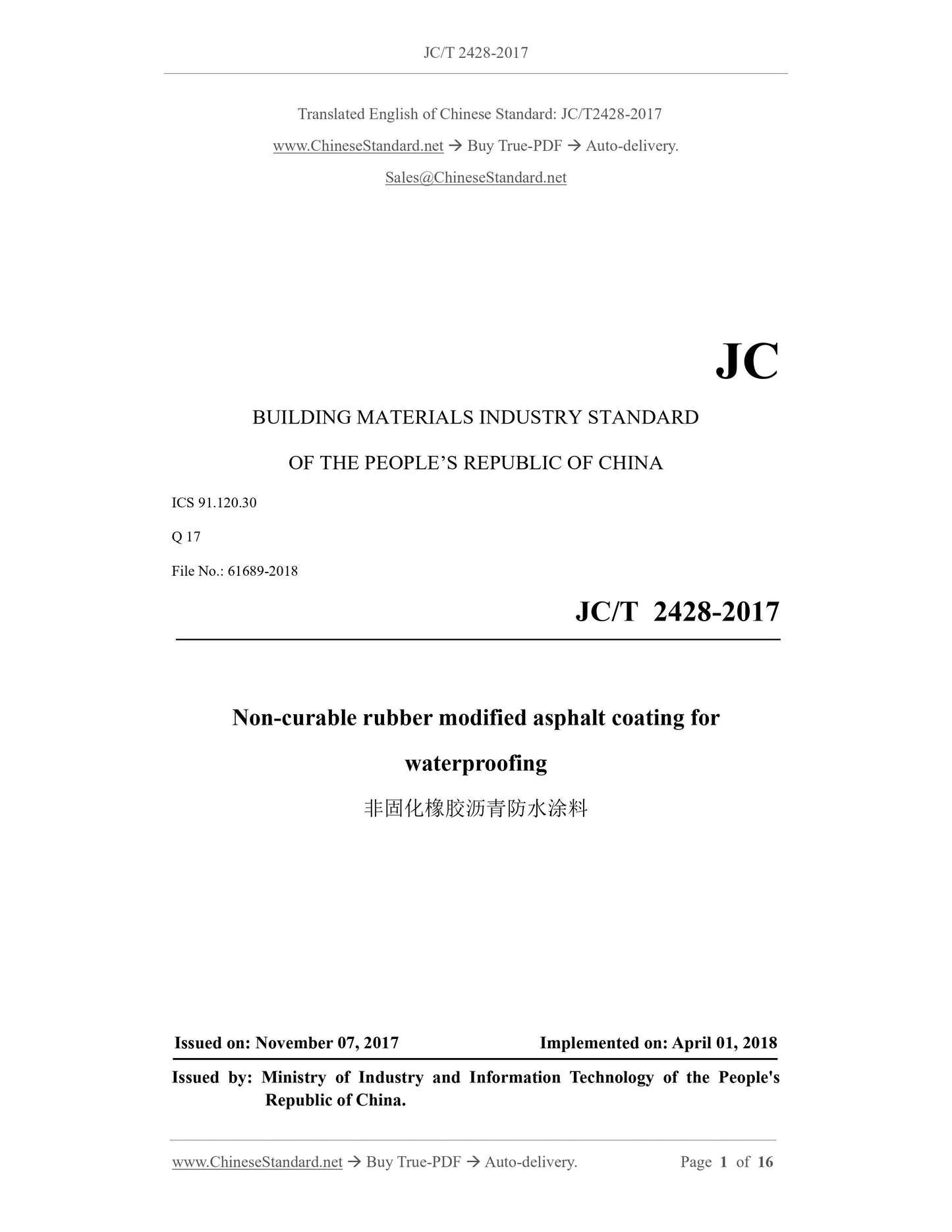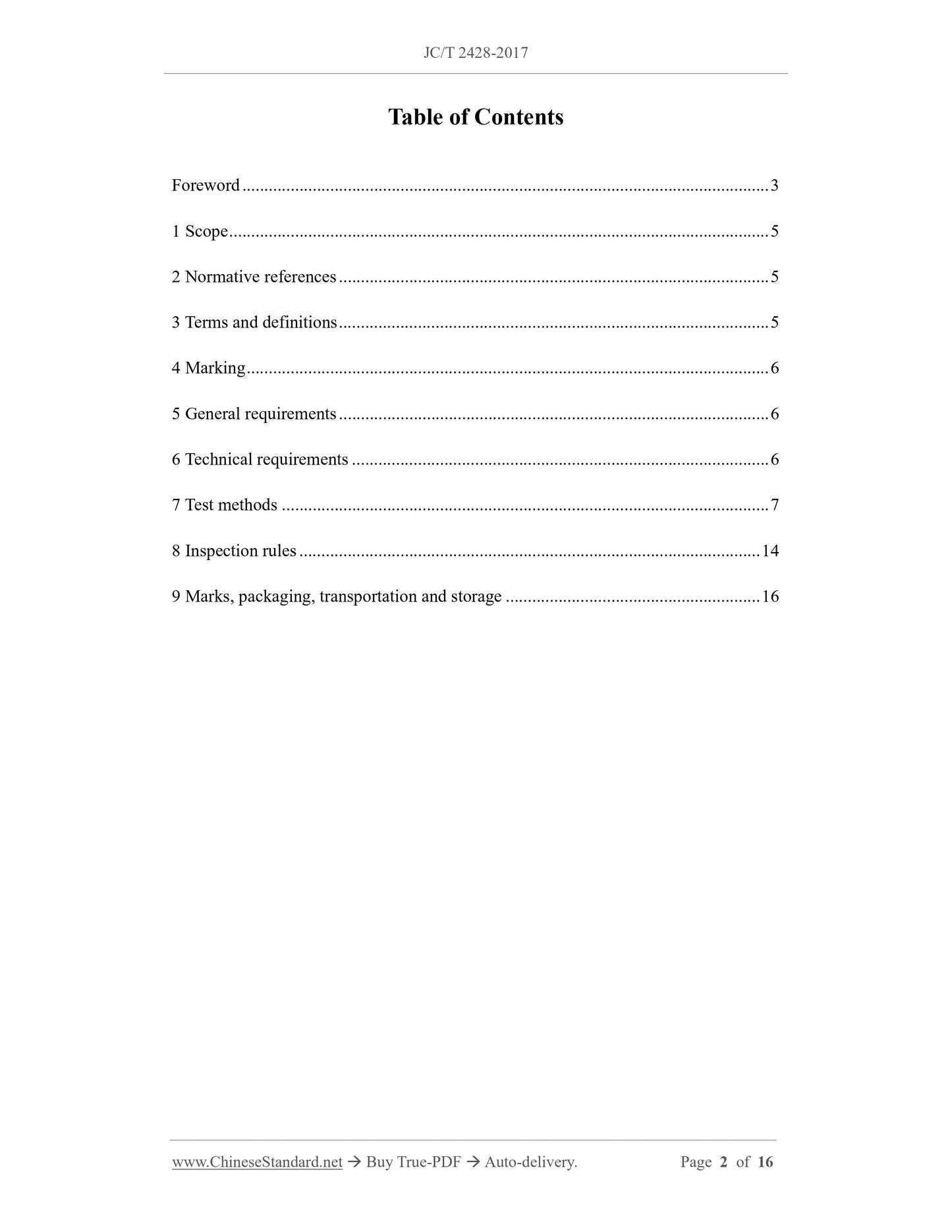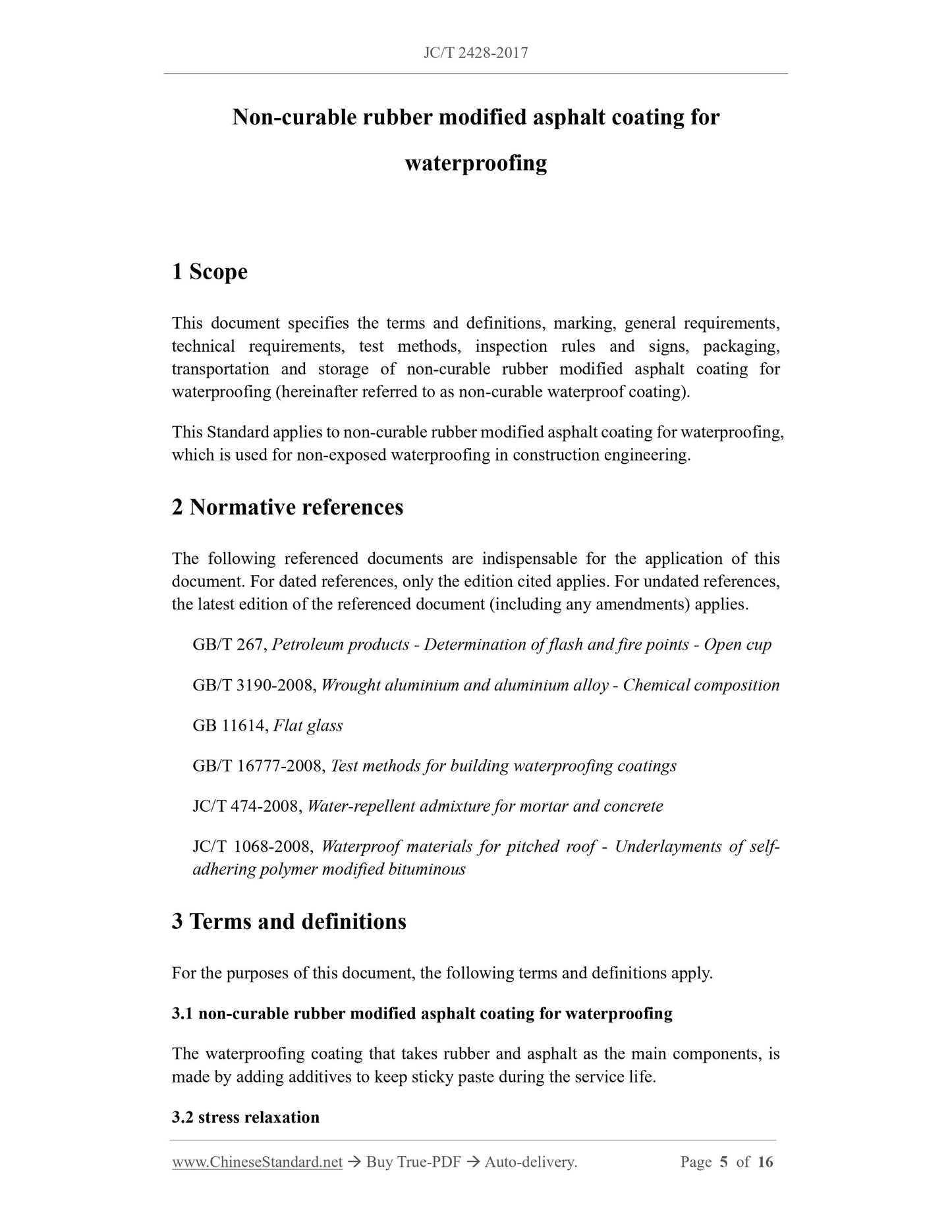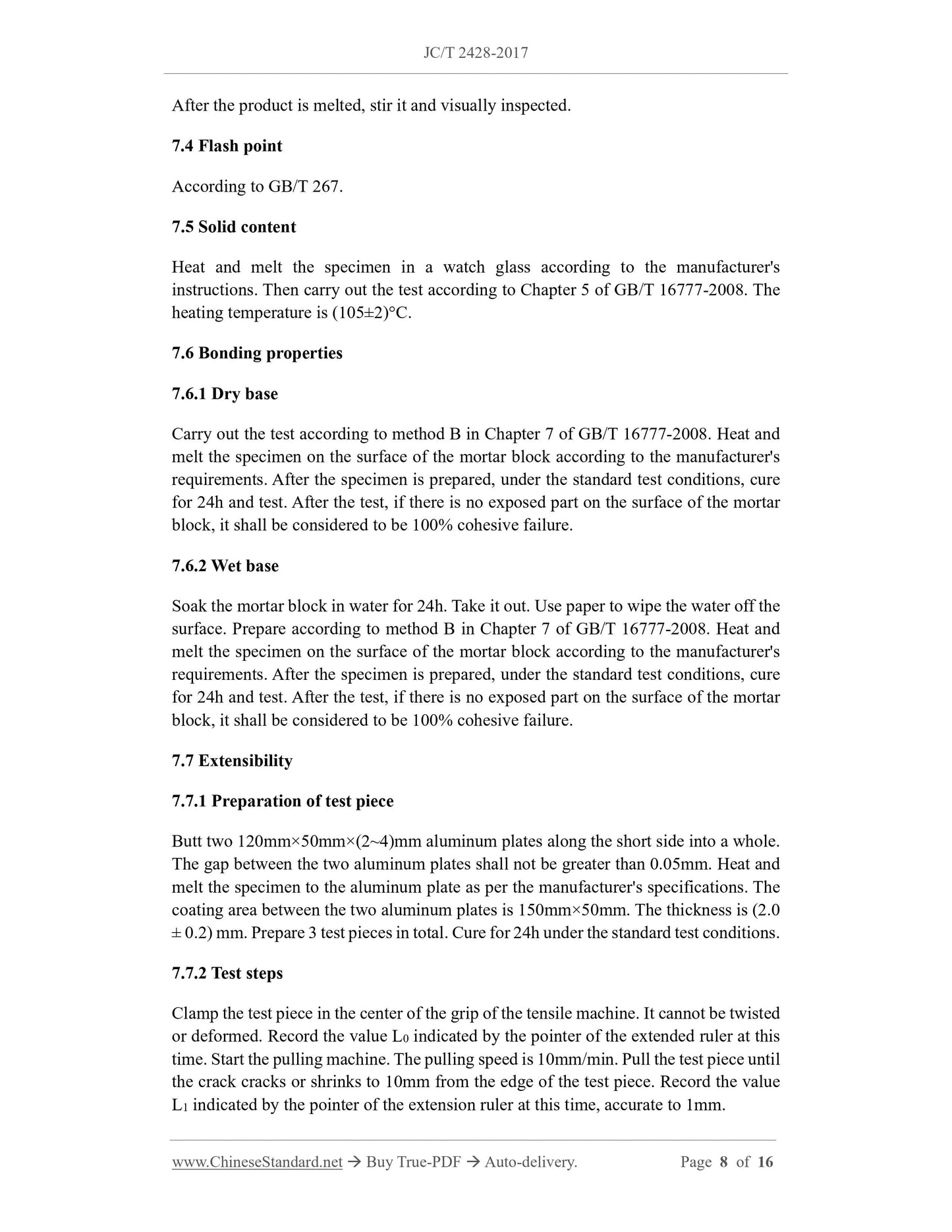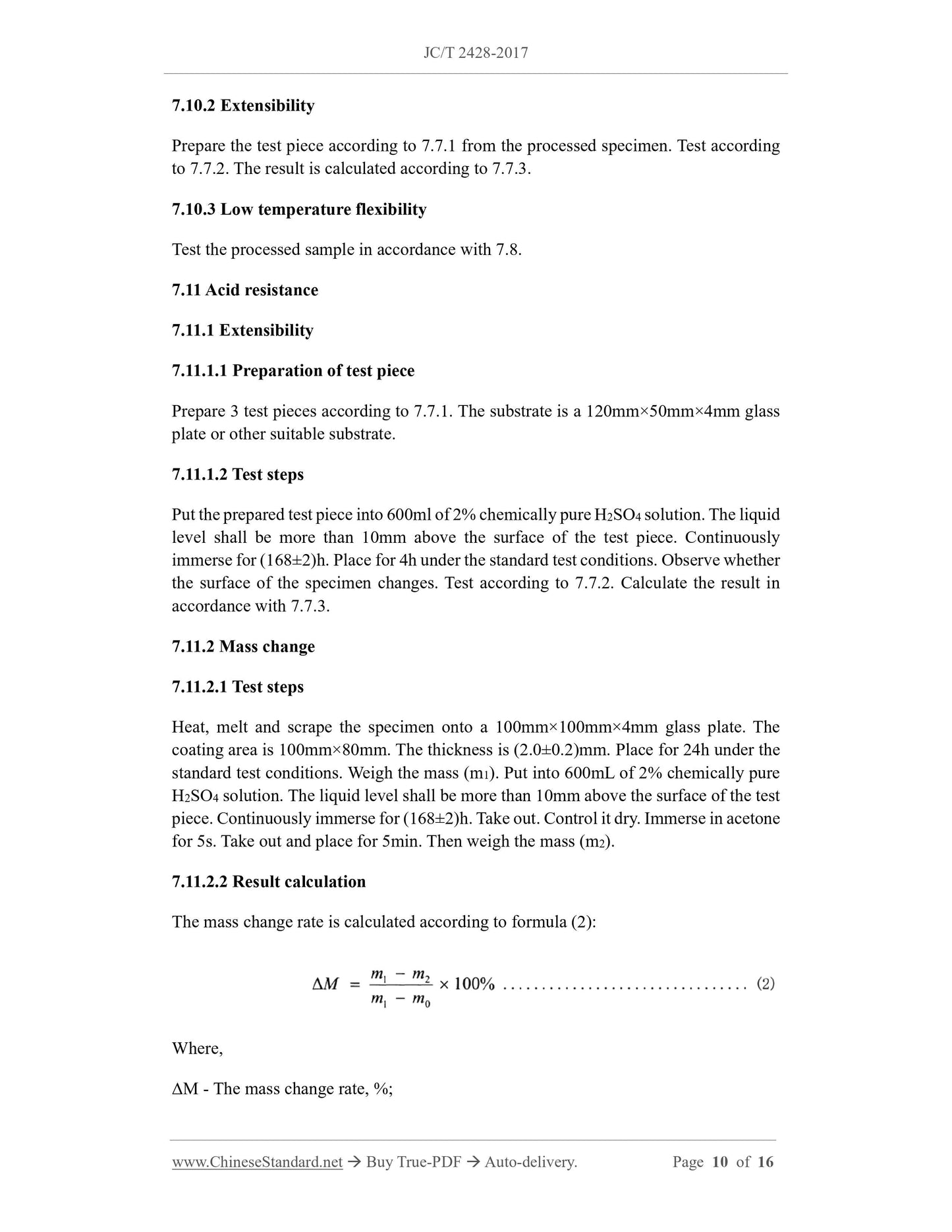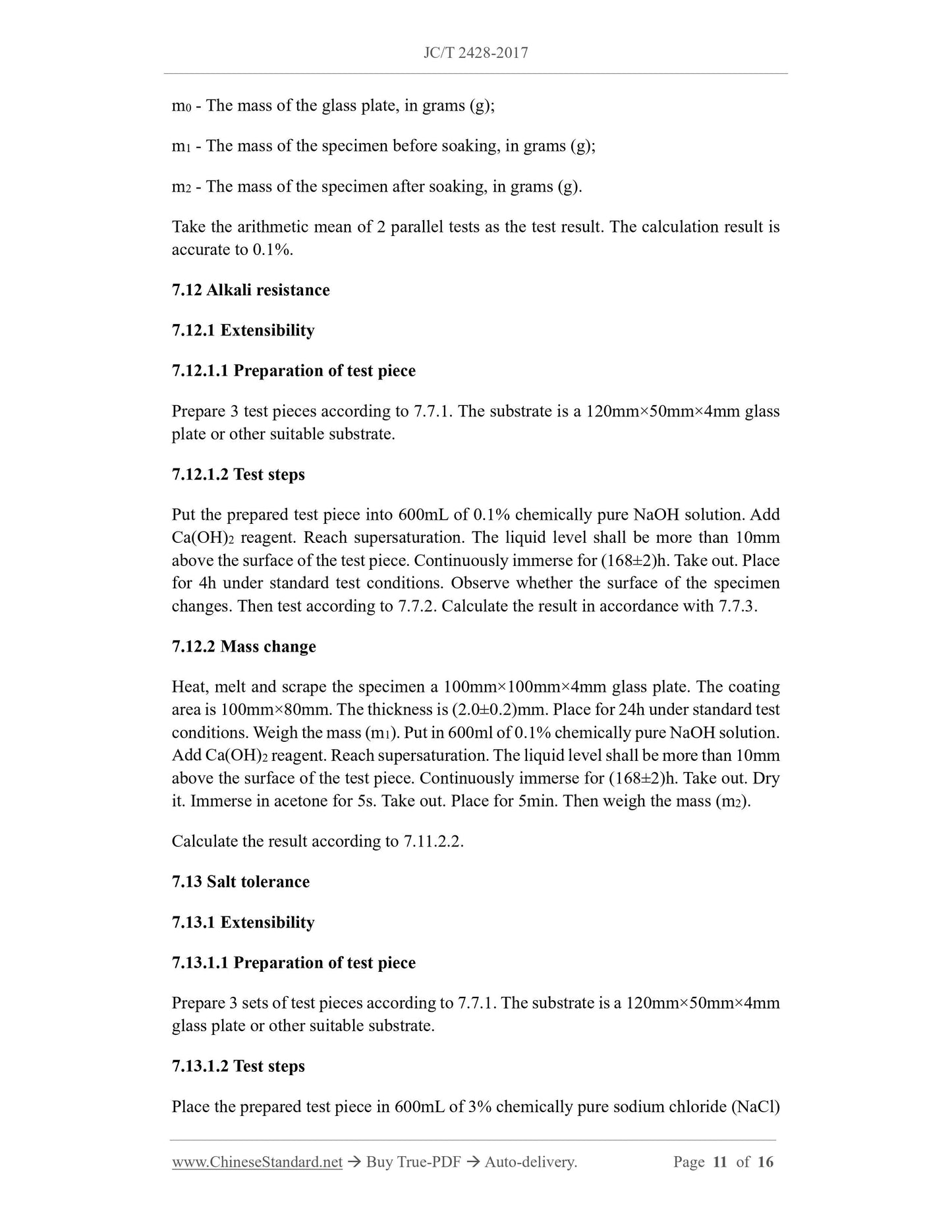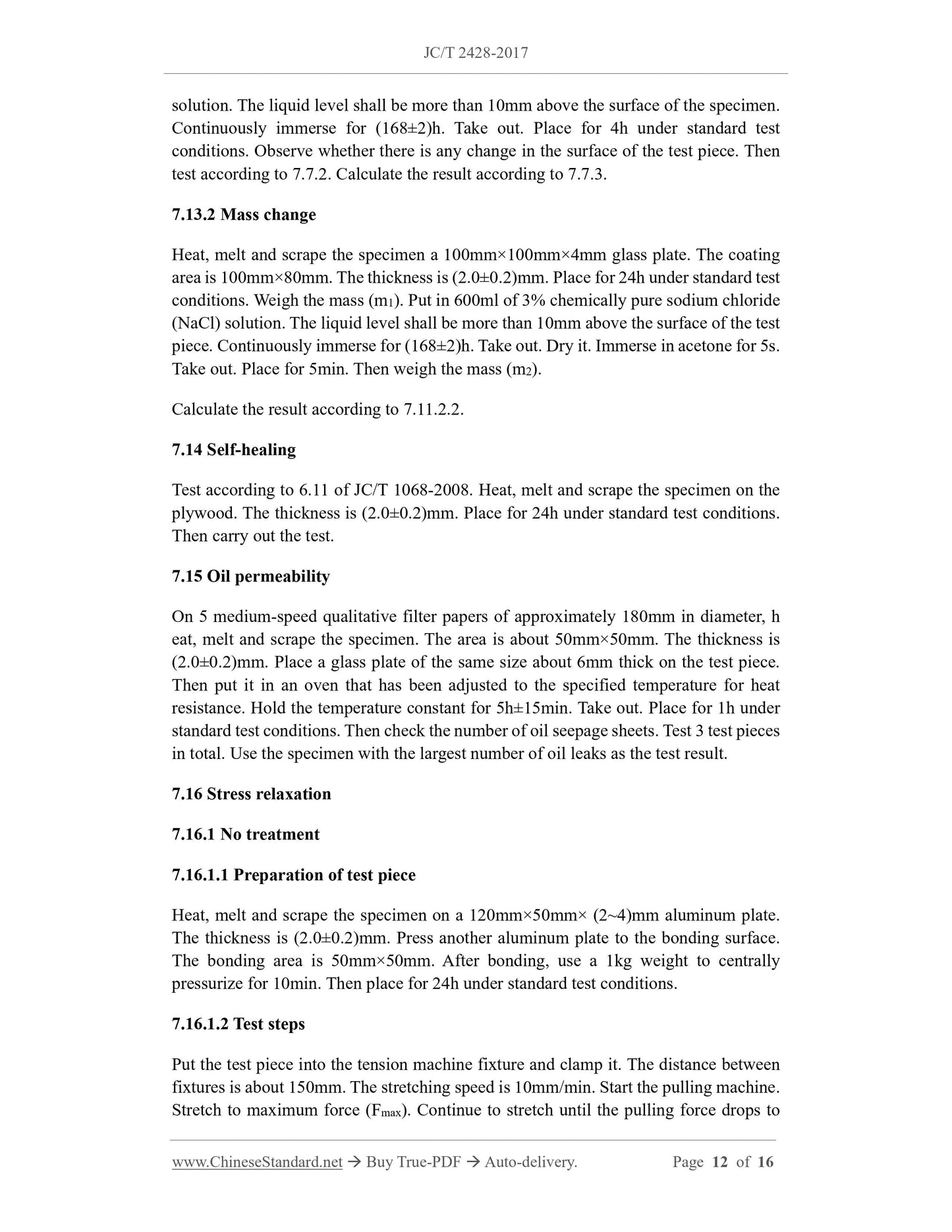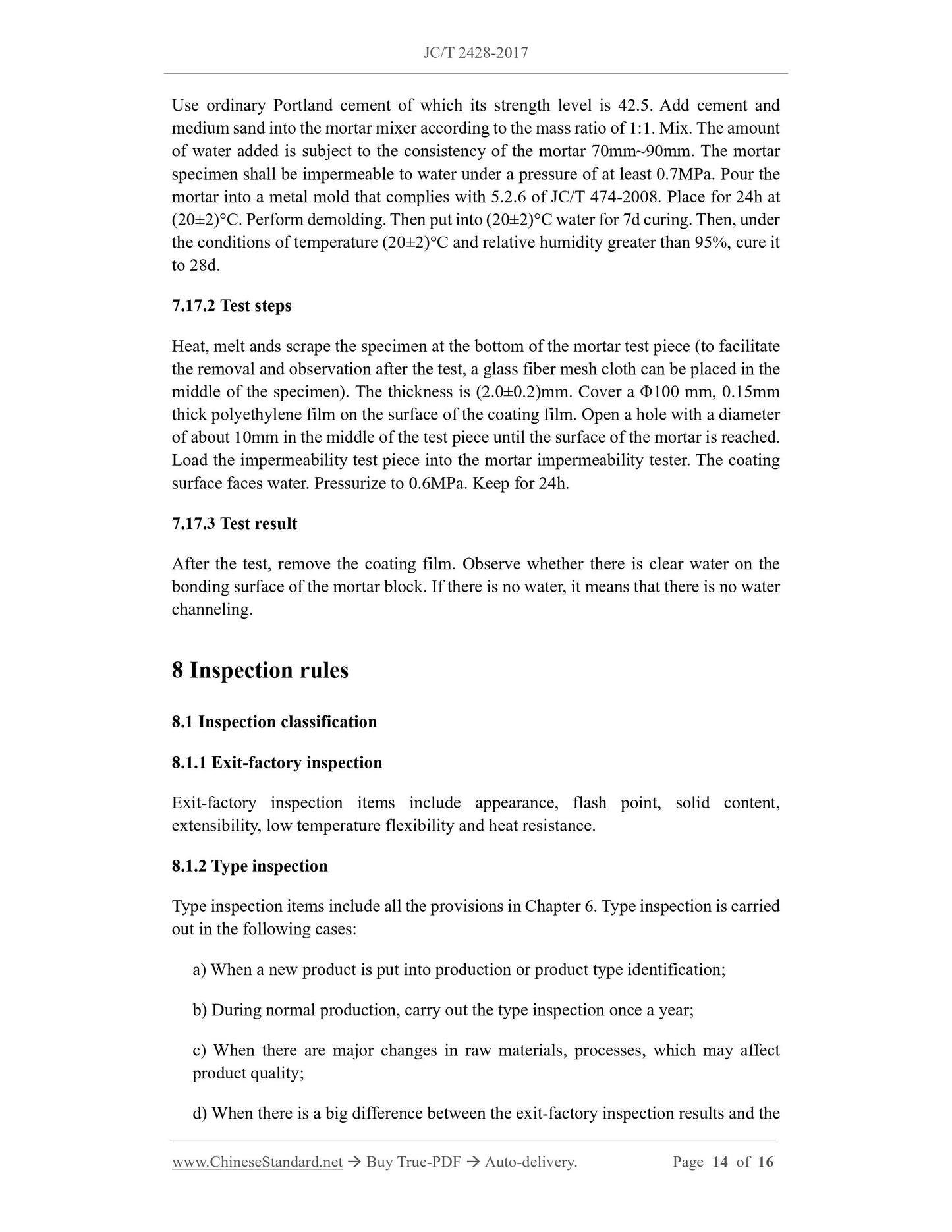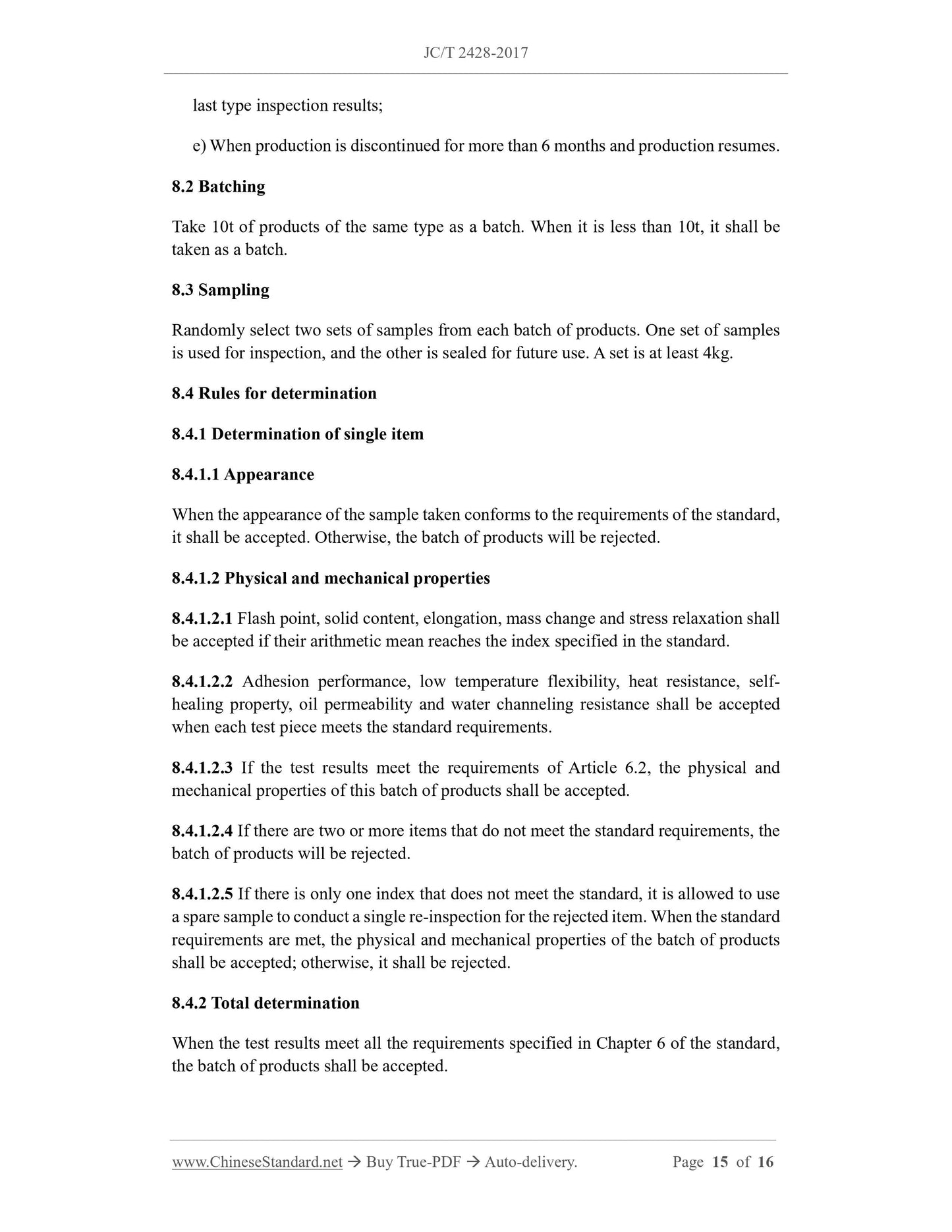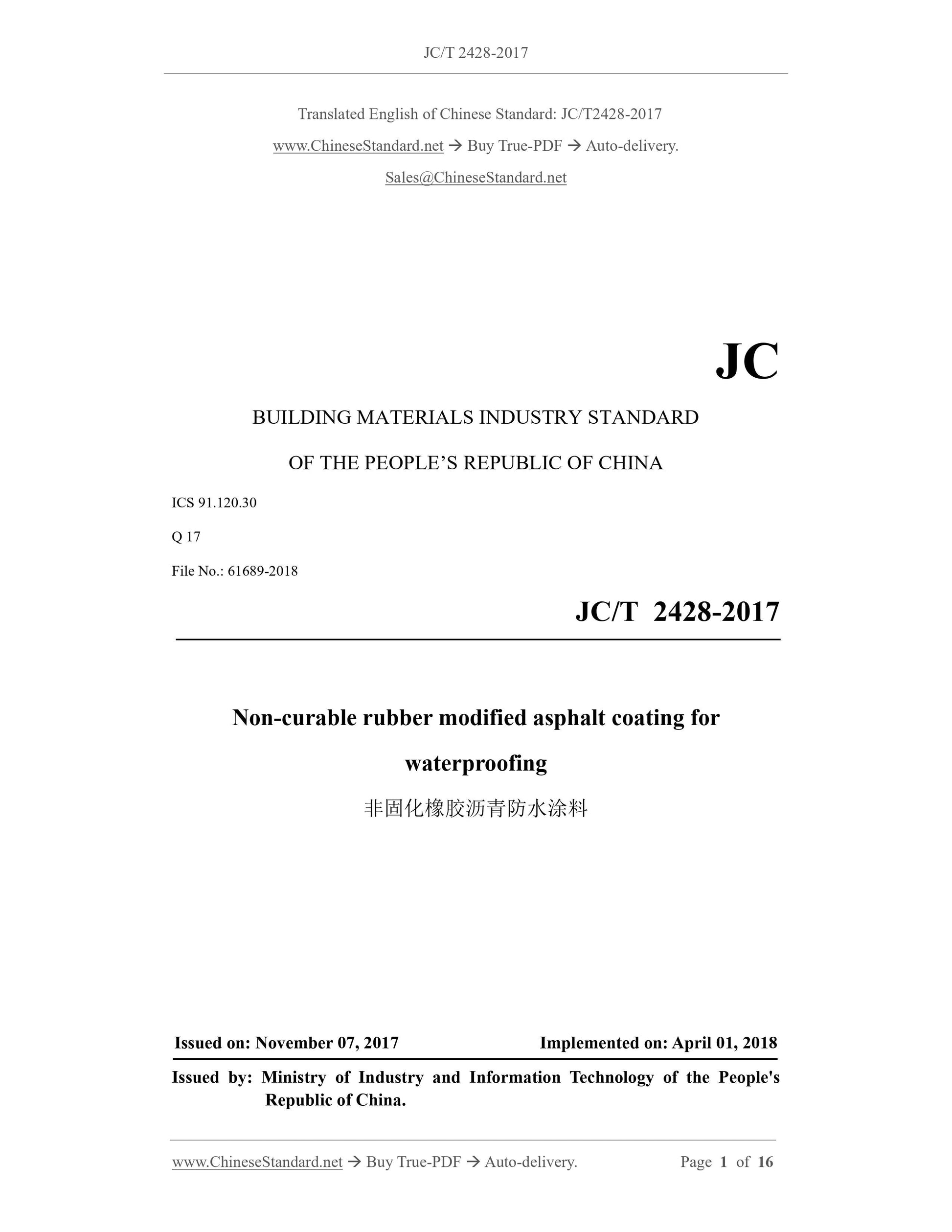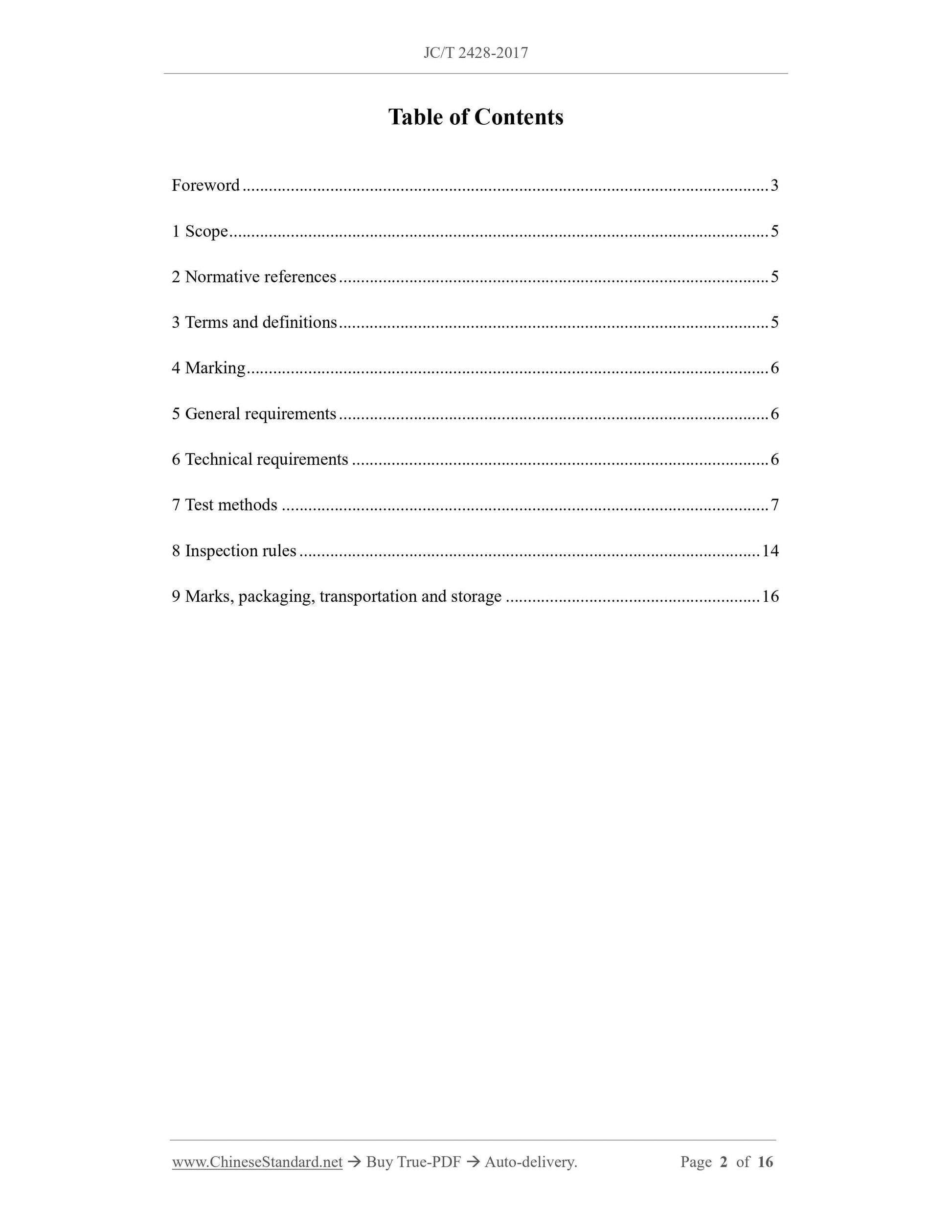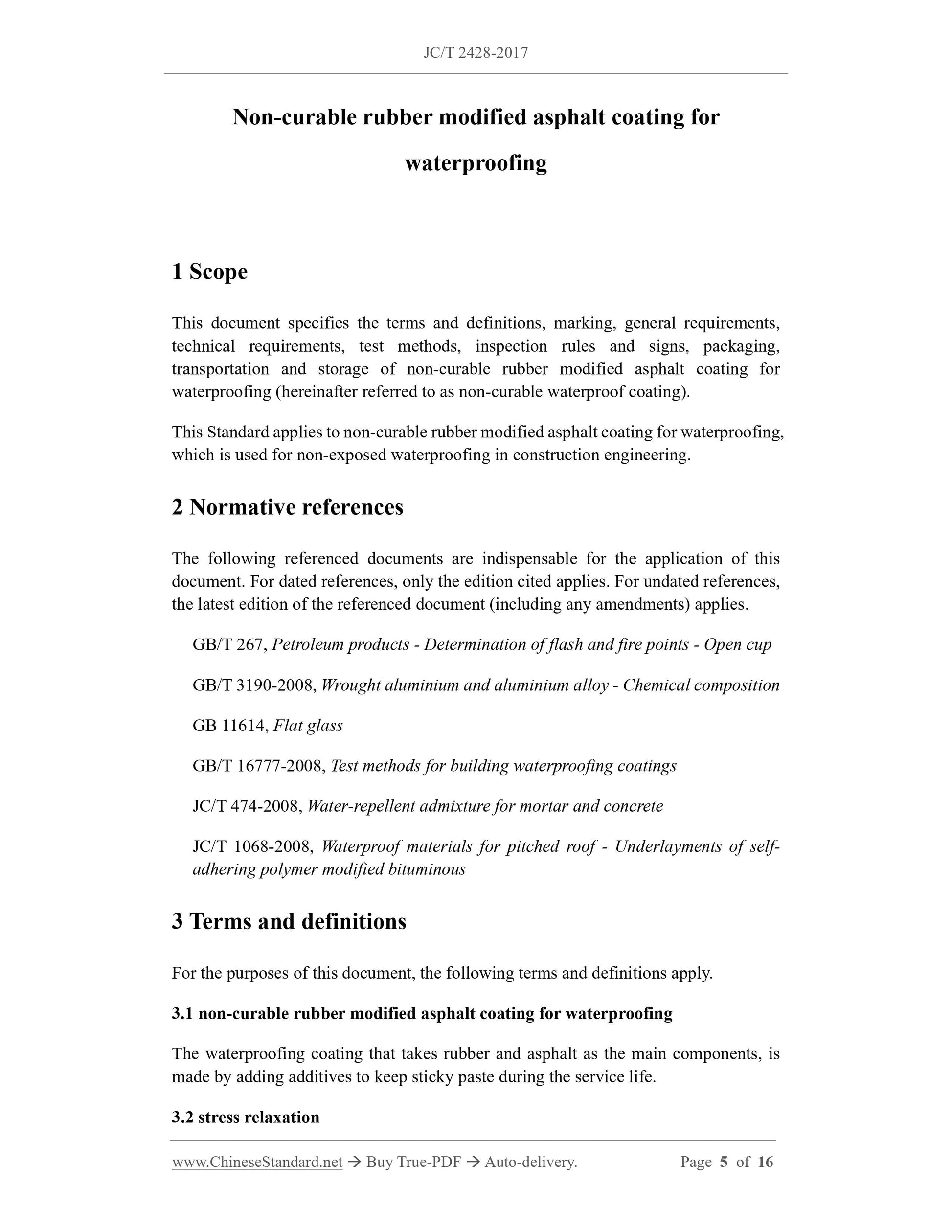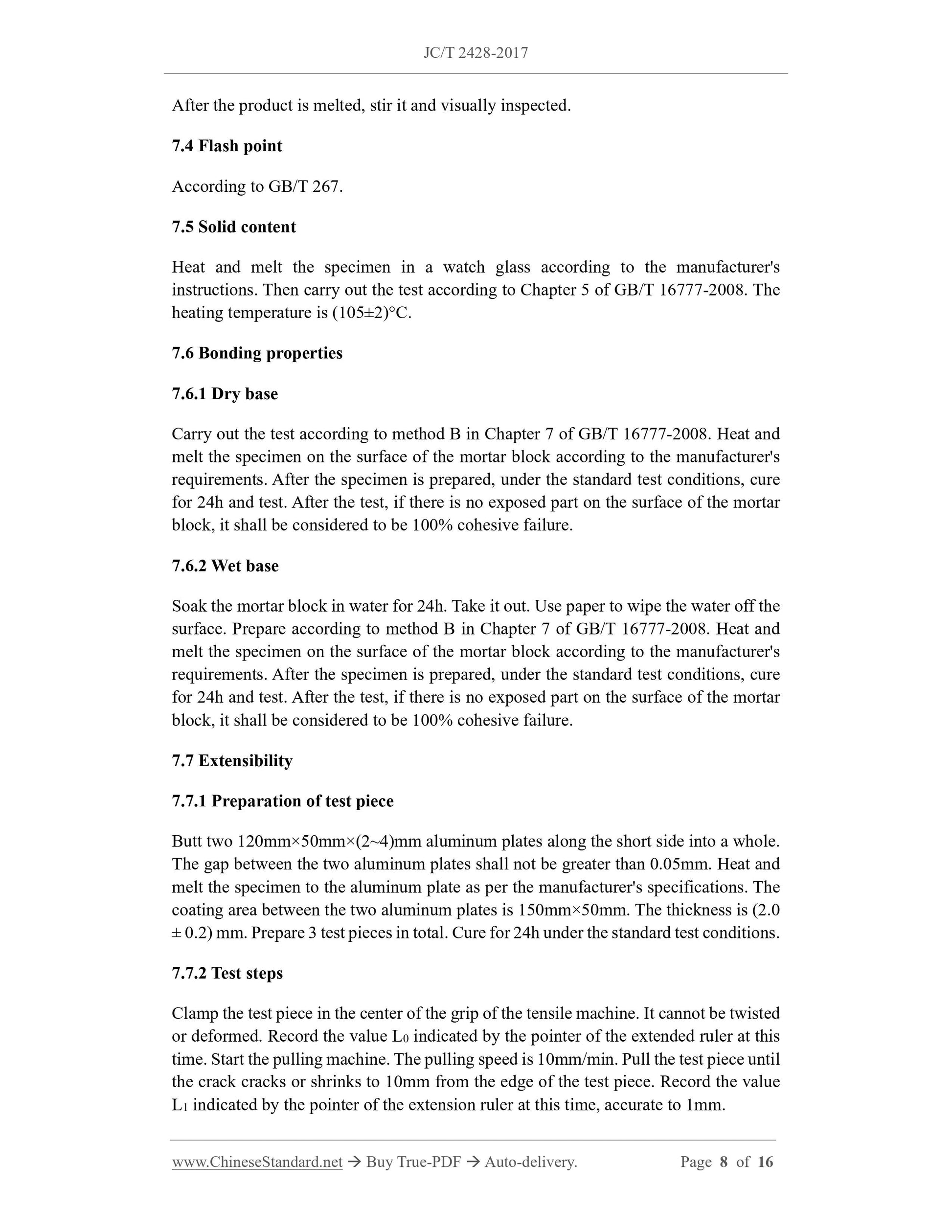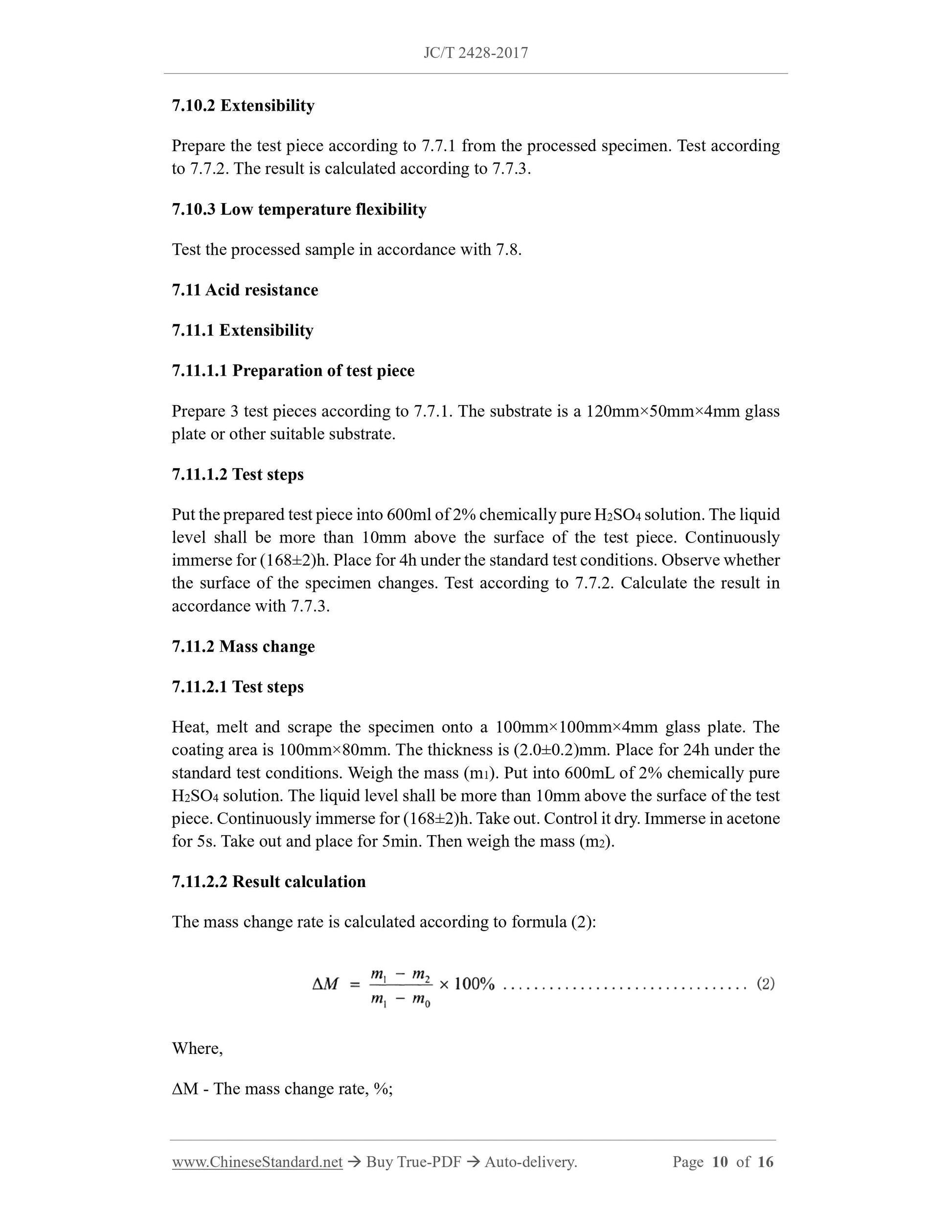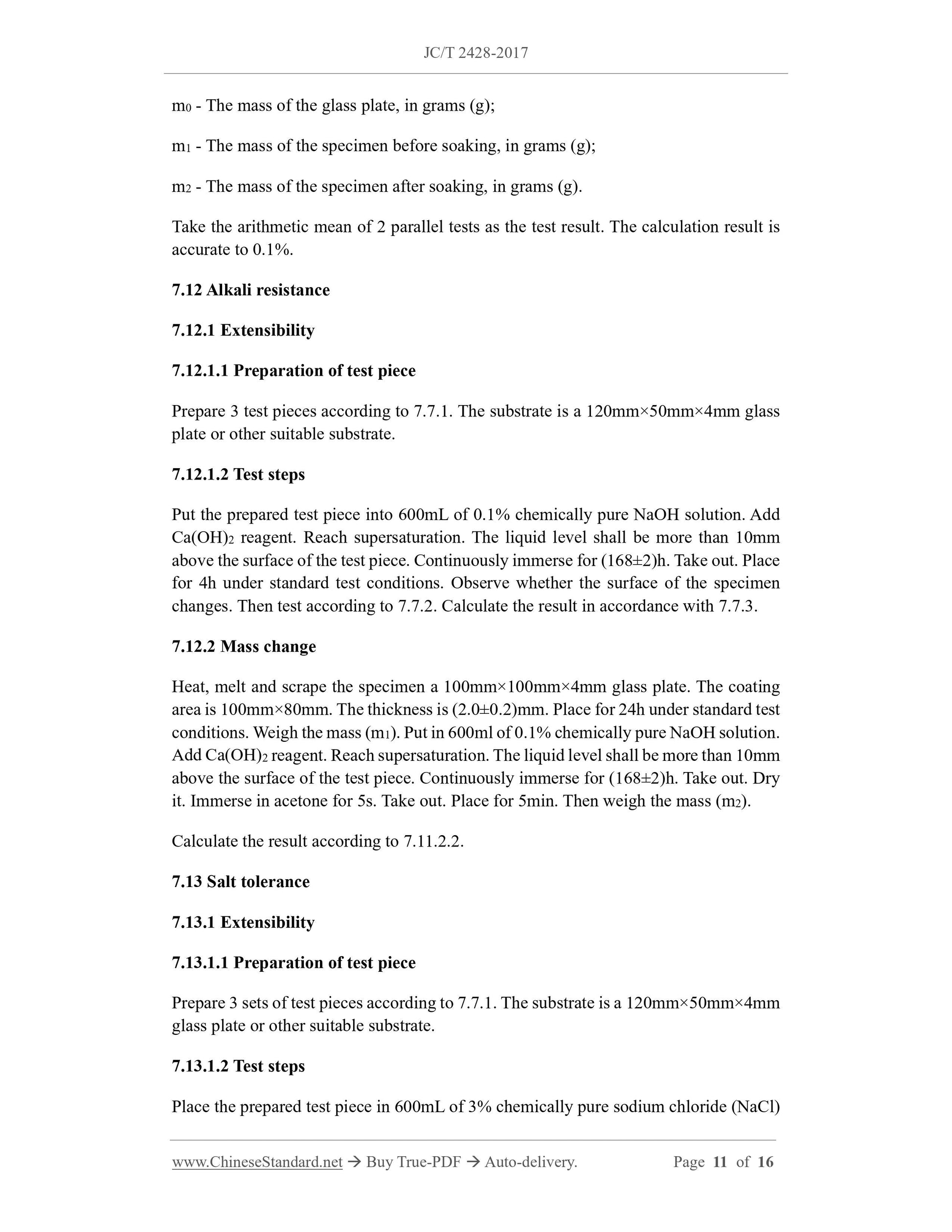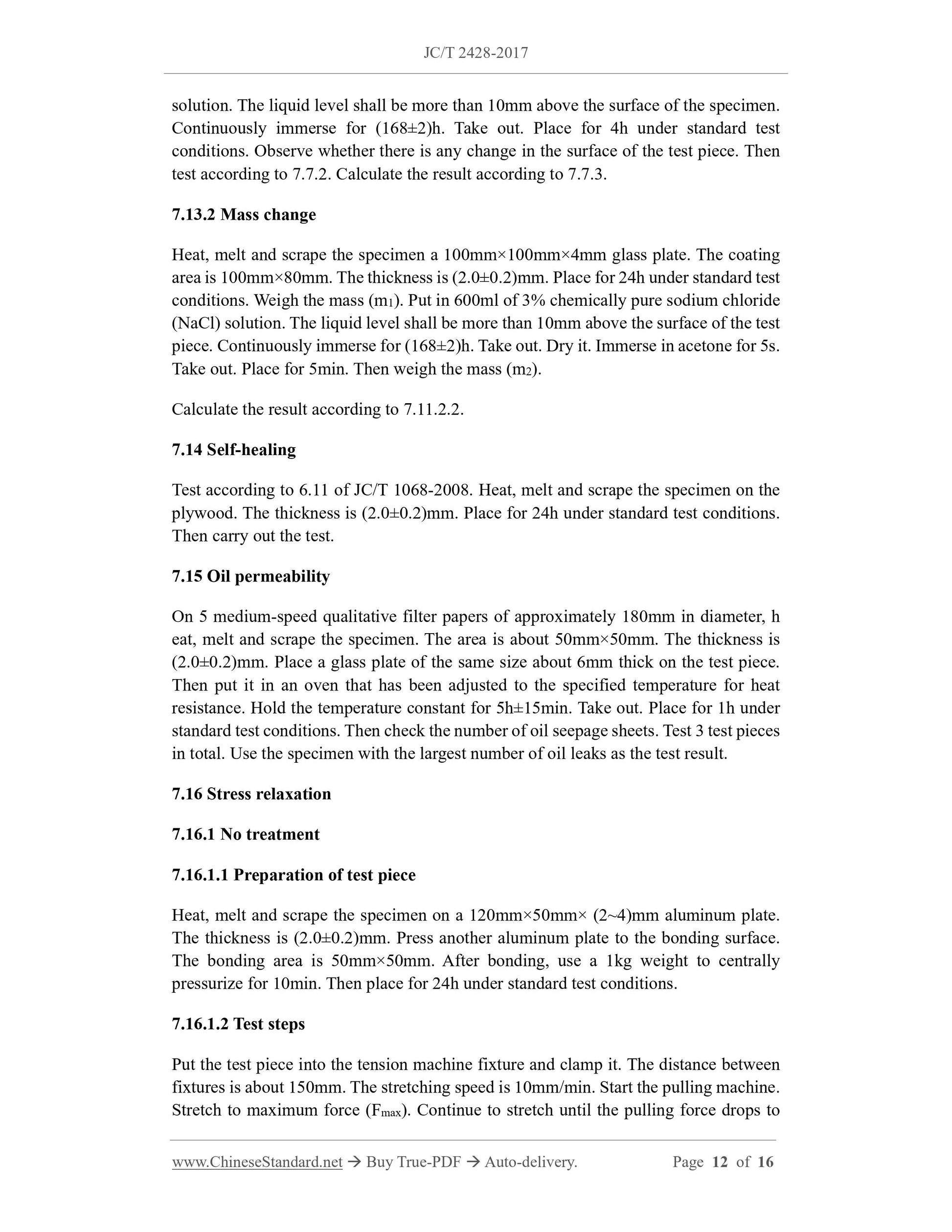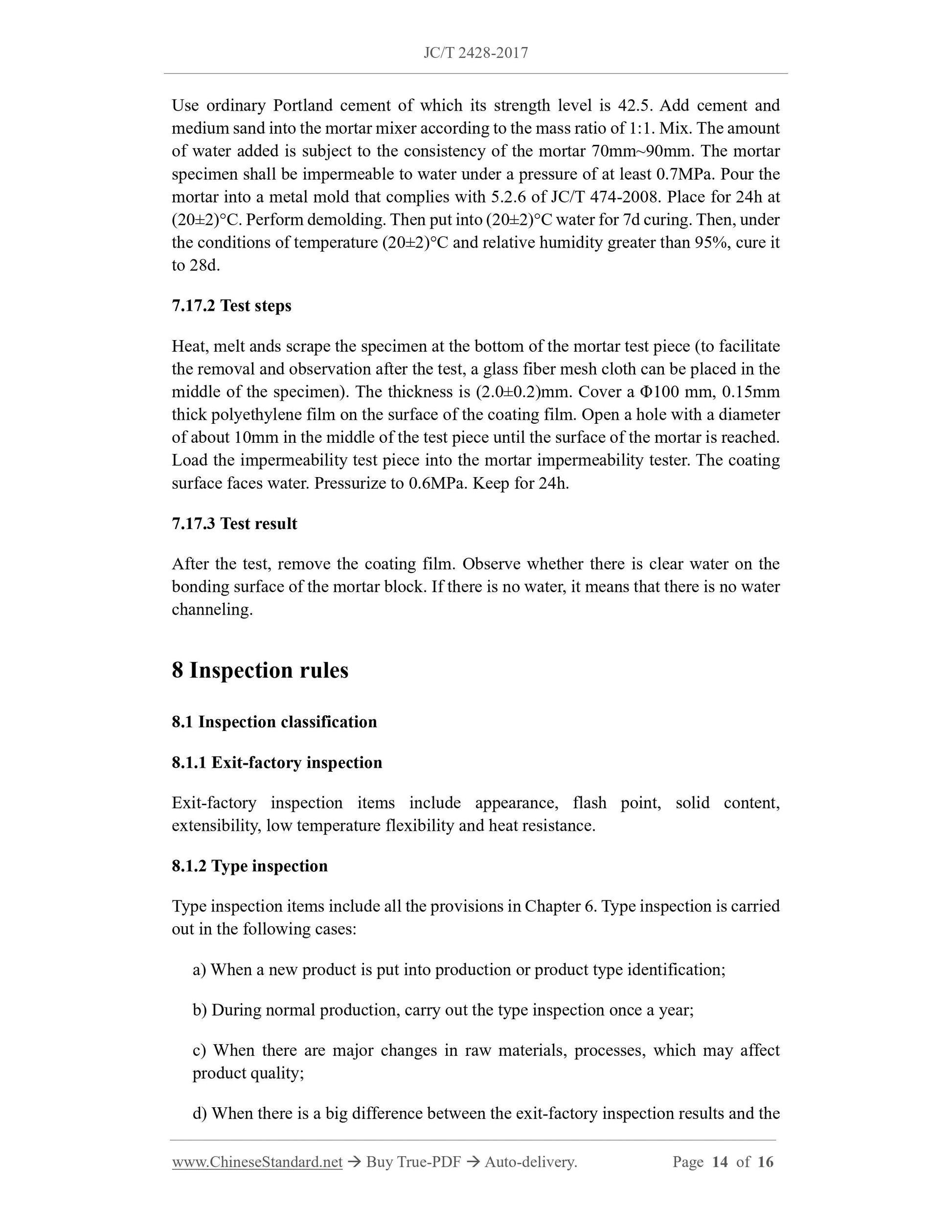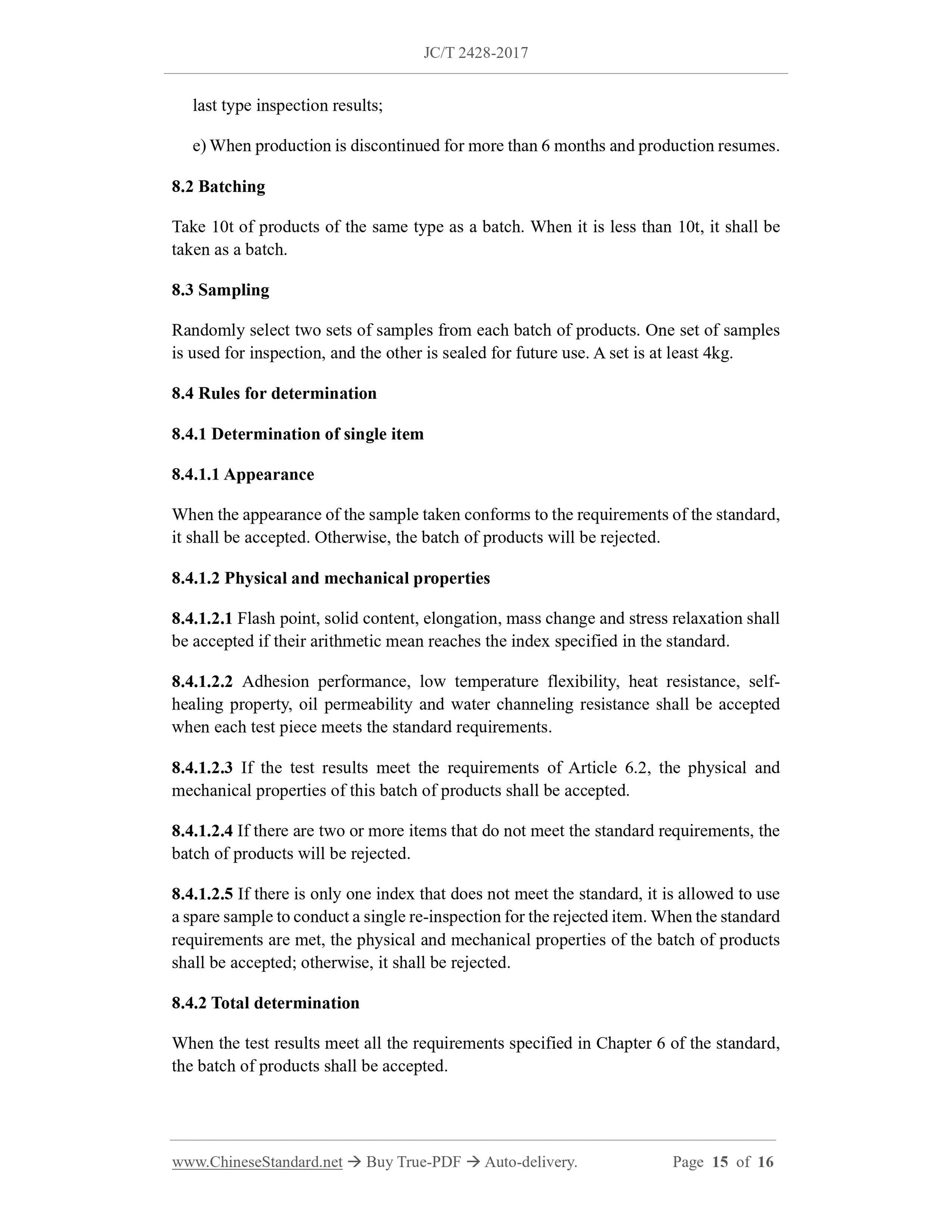1
/
of
9
PayPal, credit cards. Download editable-PDF and invoice in 1 second!
JC/T 2428-2017 English PDF (JCT2428-2017)
JC/T 2428-2017 English PDF (JCT2428-2017)
Regular price
$210.00 USD
Regular price
Sale price
$210.00 USD
Unit price
/
per
Shipping calculated at checkout.
Couldn't load pickup availability
Delivery: 3 seconds. Download true-PDF + Invoice.
Get QUOTATION in 1-minute: Click JC/T 2428-2017
Historical versions: JC/T 2428-2017
Preview True-PDF (Reload/Scroll if blank)
JC/T 2428-2017: Non-curable rubber modified asphalt coating for waterproofing
JC/T 2428-2017
JC
BUILDING MATERIALS INDUSTRY STANDARD
OF THE PEOPLE’S REPUBLIC OF CHINA
ICS 91.120.30
Q 17
File No.: 61689-2018
Non-curable rubber modified asphalt coating for
waterproofing
非固化橡胶沥青防水涂料
ISSUED ON: NOVEMBER 07, 2017
IMPLEMENTED ON: APRIL 01, 2018
Issued by: Ministry of Industry and Information Technology of the People's
Republic of China.
Table of Contents
Foreword ... 3
1 Scope ... 5
2 Normative references ... 5
3 Terms and definitions ... 5
4 Marking ... 6
5 General requirements ... 6
6 Technical requirements ... 6
7 Test methods ... 7
8 Inspection rules ... 14
9 Marks, packaging, transportation and storage ... 16
Non-curable rubber modified asphalt coating for
waterproofing
1 Scope
This document specifies the terms and definitions, marking, general requirements,
technical requirements, test methods, inspection rules and signs, packaging,
transportation and storage of non-curable rubber modified asphalt coating for
waterproofing (hereinafter referred to as non-curable waterproof coating).
This Standard applies to non-curable rubber modified asphalt coating for waterproofing,
which is used for non-exposed waterproofing in construction engineering.
2 Normative references
The following referenced documents are indispensable for the application of this
document. For dated references, only the edition cited applies. For undated references,
the latest edition of the referenced document (including any amendments) applies.
GB/T 267, Petroleum products - Determination of flash and fire points - Open cup
GB/T 3190-2008, Wrought aluminium and aluminium alloy - Chemical composition
GB 11614, Flat glass
GB/T 16777-2008, Test methods for building waterproofing coatings
JC/T 474-2008, Water-repellent admixture for mortar and concrete
JC/T 1068-2008, Waterproof materials for pitched roof - Underlayments of self-
adhering polymer modified bituminous
3 Terms and definitions
For the purposes of this document, the following terms and definitions apply.
3.1 non-curable rubber modified asphalt coating for waterproofing
The waterproofing coating that takes rubber and asphalt as the main components, is
made by adding additives to keep sticky paste during the service life.
3.2 stress relaxation
After the product is melted, stir it and visually inspected.
7.4 Flash point
According to GB/T 267.
7.5 Solid content
Heat and melt the specimen in a watch glass according to the manufacturer's
instructions. Then carry out the test according to Chapter 5 of GB/T 16777-2008. The
heating temperature is (105±2)°C.
7.6 Bonding properties
7.6.1 Dry base
Carry out the test according to method B in Chapter 7 of GB/T 16777-2008. Heat and
melt the specimen on the surface of the mortar block according to the manufacturer's
requirements. After the specimen is prepared, under the standard test conditions, cure
for 24h and test. After the test, if there is no exposed part on the surface of the mortar
block, it shall be considered to be 100% cohesive failure.
7.6.2 Wet base
Soak the mortar block in water for 24h. Take it out. Use paper to wipe the water off the
surface. Prepare according to method B in Chapter 7 of GB/T 16777-2008. Heat and
melt the specimen on the surface of the mortar block according to the manufacturer's
requirements. After the specimen is prepared, under the standard test conditions, cure
for 24h and test. After the test, if there is no exposed part on the surface of the mortar
block, it shall be considered to be 100% cohesive failure.
7.7 Extensibility
7.7.1 Preparation of test piece
Butt two 120mm×50mm×(2~4)mm aluminum plates along the short side into a whole.
The gap between the two aluminum plates shall not be greater than 0.05mm. Heat and
melt the specimen to the aluminum plate as per the manufacturer's specifications. The
coating area between the two aluminum plates is 150mm×50mm. The thickness is (2.0
± 0.2) mm. Prepare 3 test pieces in total. Cure for 24h under the standard test conditions.
7.7.2 Test steps
Clamp the test piece in the center of the grip of the tensile machine. It cannot be twisted
or deformed. Record the value L0 indicated by the pointer of the extended ruler at this
time. Start the pulling machine. The pulling speed is 10mm/min. Pull the test piece until
the crack cracks or shrinks to 10mm from the edge of the test piece. Record the value
L1 indicated by the pointer of the extension ruler at this time, accurate to 1mm.
7.10.2 Extensibility
Prepare the test piece according to 7.7.1 from the processed specimen. Test according
to 7.7.2. The result is calculated according to 7.7.3.
7.10.3 Low temperature flexibility
Test the processed sample in accordance with 7.8.
7.11 Acid resistance
7.11.1 Extensibility
7.11.1.1 Preparation of test piece
Prepare 3 test pieces according to 7.7.1. The substrate is a 120mm×50mm×4mm glass
plate or other suitable substrate.
7.11.1.2 Test steps
Put the prepared test piece into 600ml of 2% chemically pure H2SO4 solution. The liquid
level shall be more than 10mm above the surface of the test piece. Continuously
immerse for (168±2)h. Place for 4h under the standard test conditions. Observe whether
the surface of the specimen changes. Test according to 7.7.2. Calculate the result in
accordance with 7.7.3.
7.11.2 Mass change
7.11.2.1 Test steps
Heat, melt and scrape the specimen onto a 100mm×100mm×4mm glass plate. The
coating area is 100mm×80mm. The thickness is (2.0±0.2)mm. Place for 24h under the
standard test conditions. Weigh the mass (m1). Put into 600mL of 2% chemically pure
H2SO4 solution. The liquid level shall be more than 10mm above the surface of the test
piece. Continuously immerse for (168±2)h. Take out. Control it dry. Immerse in acetone
for 5s. Take out and place for 5min. Then weigh the mass (m2).
7.11.2.2 Result calculation
The mass change rate is calculated according to formula (2):
Where,
ΔM - The mass change rate, %;
m0 - The mass of the glass plate, in grams (g);
m1 - The mass of the specimen before soaking, in grams (g);
m2 - The mass of the specimen after soaking, in grams (g).
Take the arithmetic mean of 2 parallel tests as the test result. The calculation result is
accurate to 0.1%.
7.12 Alkali resistance
7.12.1 Extensibility
7.12.1.1 Preparation of test piece
Prepare 3 test pieces according to 7.7.1. The substrate is a 120mm×50mm×4mm glass
plate or other suitable substrate.
7.12.1.2 Test steps
Put the prepared test piece into 600mL of 0.1% chemically pure NaOH solution. Add
Ca(OH)2 reagent. Reach supersaturation. The liquid level shall be more than 10mm
above the surface of the test piece. Continuously immerse for (168±2)h. Take out. Place
for 4h under standard test conditions. Observe whether the surface of the specimen
changes. Then test according to 7.7.2. Calculate the result in accordance with 7.7.3.
7.12.2 Mass change
Heat, melt and scrape the specimen a 100mm×100mm×4mm glass plate. The coating
area is 100mm×80mm. The thickness is (2.0±0.2)mm. Place for 24h under standard test
conditions. Weigh the mass (m1). Put in 600ml of 0.1% chemically pure NaOH solution.
Add Ca(OH)2 reagent. Reach supersaturation. The liquid level shall be more than 10mm
above the surface of the test piece. Continuously immerse for (168±2)h. Take out. Dry
it. Immerse in acetone for 5s. Take out. Place for 5min. Then weigh the mass (m2).
Cal...
Get QUOTATION in 1-minute: Click JC/T 2428-2017
Historical versions: JC/T 2428-2017
Preview True-PDF (Reload/Scroll if blank)
JC/T 2428-2017: Non-curable rubber modified asphalt coating for waterproofing
JC/T 2428-2017
JC
BUILDING MATERIALS INDUSTRY STANDARD
OF THE PEOPLE’S REPUBLIC OF CHINA
ICS 91.120.30
Q 17
File No.: 61689-2018
Non-curable rubber modified asphalt coating for
waterproofing
非固化橡胶沥青防水涂料
ISSUED ON: NOVEMBER 07, 2017
IMPLEMENTED ON: APRIL 01, 2018
Issued by: Ministry of Industry and Information Technology of the People's
Republic of China.
Table of Contents
Foreword ... 3
1 Scope ... 5
2 Normative references ... 5
3 Terms and definitions ... 5
4 Marking ... 6
5 General requirements ... 6
6 Technical requirements ... 6
7 Test methods ... 7
8 Inspection rules ... 14
9 Marks, packaging, transportation and storage ... 16
Non-curable rubber modified asphalt coating for
waterproofing
1 Scope
This document specifies the terms and definitions, marking, general requirements,
technical requirements, test methods, inspection rules and signs, packaging,
transportation and storage of non-curable rubber modified asphalt coating for
waterproofing (hereinafter referred to as non-curable waterproof coating).
This Standard applies to non-curable rubber modified asphalt coating for waterproofing,
which is used for non-exposed waterproofing in construction engineering.
2 Normative references
The following referenced documents are indispensable for the application of this
document. For dated references, only the edition cited applies. For undated references,
the latest edition of the referenced document (including any amendments) applies.
GB/T 267, Petroleum products - Determination of flash and fire points - Open cup
GB/T 3190-2008, Wrought aluminium and aluminium alloy - Chemical composition
GB 11614, Flat glass
GB/T 16777-2008, Test methods for building waterproofing coatings
JC/T 474-2008, Water-repellent admixture for mortar and concrete
JC/T 1068-2008, Waterproof materials for pitched roof - Underlayments of self-
adhering polymer modified bituminous
3 Terms and definitions
For the purposes of this document, the following terms and definitions apply.
3.1 non-curable rubber modified asphalt coating for waterproofing
The waterproofing coating that takes rubber and asphalt as the main components, is
made by adding additives to keep sticky paste during the service life.
3.2 stress relaxation
After the product is melted, stir it and visually inspected.
7.4 Flash point
According to GB/T 267.
7.5 Solid content
Heat and melt the specimen in a watch glass according to the manufacturer's
instructions. Then carry out the test according to Chapter 5 of GB/T 16777-2008. The
heating temperature is (105±2)°C.
7.6 Bonding properties
7.6.1 Dry base
Carry out the test according to method B in Chapter 7 of GB/T 16777-2008. Heat and
melt the specimen on the surface of the mortar block according to the manufacturer's
requirements. After the specimen is prepared, under the standard test conditions, cure
for 24h and test. After the test, if there is no exposed part on the surface of the mortar
block, it shall be considered to be 100% cohesive failure.
7.6.2 Wet base
Soak the mortar block in water for 24h. Take it out. Use paper to wipe the water off the
surface. Prepare according to method B in Chapter 7 of GB/T 16777-2008. Heat and
melt the specimen on the surface of the mortar block according to the manufacturer's
requirements. After the specimen is prepared, under the standard test conditions, cure
for 24h and test. After the test, if there is no exposed part on the surface of the mortar
block, it shall be considered to be 100% cohesive failure.
7.7 Extensibility
7.7.1 Preparation of test piece
Butt two 120mm×50mm×(2~4)mm aluminum plates along the short side into a whole.
The gap between the two aluminum plates shall not be greater than 0.05mm. Heat and
melt the specimen to the aluminum plate as per the manufacturer's specifications. The
coating area between the two aluminum plates is 150mm×50mm. The thickness is (2.0
± 0.2) mm. Prepare 3 test pieces in total. Cure for 24h under the standard test conditions.
7.7.2 Test steps
Clamp the test piece in the center of the grip of the tensile machine. It cannot be twisted
or deformed. Record the value L0 indicated by the pointer of the extended ruler at this
time. Start the pulling machine. The pulling speed is 10mm/min. Pull the test piece until
the crack cracks or shrinks to 10mm from the edge of the test piece. Record the value
L1 indicated by the pointer of the extension ruler at this time, accurate to 1mm.
7.10.2 Extensibility
Prepare the test piece according to 7.7.1 from the processed specimen. Test according
to 7.7.2. The result is calculated according to 7.7.3.
7.10.3 Low temperature flexibility
Test the processed sample in accordance with 7.8.
7.11 Acid resistance
7.11.1 Extensibility
7.11.1.1 Preparation of test piece
Prepare 3 test pieces according to 7.7.1. The substrate is a 120mm×50mm×4mm glass
plate or other suitable substrate.
7.11.1.2 Test steps
Put the prepared test piece into 600ml of 2% chemically pure H2SO4 solution. The liquid
level shall be more than 10mm above the surface of the test piece. Continuously
immerse for (168±2)h. Place for 4h under the standard test conditions. Observe whether
the surface of the specimen changes. Test according to 7.7.2. Calculate the result in
accordance with 7.7.3.
7.11.2 Mass change
7.11.2.1 Test steps
Heat, melt and scrape the specimen onto a 100mm×100mm×4mm glass plate. The
coating area is 100mm×80mm. The thickness is (2.0±0.2)mm. Place for 24h under the
standard test conditions. Weigh the mass (m1). Put into 600mL of 2% chemically pure
H2SO4 solution. The liquid level shall be more than 10mm above the surface of the test
piece. Continuously immerse for (168±2)h. Take out. Control it dry. Immerse in acetone
for 5s. Take out and place for 5min. Then weigh the mass (m2).
7.11.2.2 Result calculation
The mass change rate is calculated according to formula (2):
Where,
ΔM - The mass change rate, %;
m0 - The mass of the glass plate, in grams (g);
m1 - The mass of the specimen before soaking, in grams (g);
m2 - The mass of the specimen after soaking, in grams (g).
Take the arithmetic mean of 2 parallel tests as the test result. The calculation result is
accurate to 0.1%.
7.12 Alkali resistance
7.12.1 Extensibility
7.12.1.1 Preparation of test piece
Prepare 3 test pieces according to 7.7.1. The substrate is a 120mm×50mm×4mm glass
plate or other suitable substrate.
7.12.1.2 Test steps
Put the prepared test piece into 600mL of 0.1% chemically pure NaOH solution. Add
Ca(OH)2 reagent. Reach supersaturation. The liquid level shall be more than 10mm
above the surface of the test piece. Continuously immerse for (168±2)h. Take out. Place
for 4h under standard test conditions. Observe whether the surface of the specimen
changes. Then test according to 7.7.2. Calculate the result in accordance with 7.7.3.
7.12.2 Mass change
Heat, melt and scrape the specimen a 100mm×100mm×4mm glass plate. The coating
area is 100mm×80mm. The thickness is (2.0±0.2)mm. Place for 24h under standard test
conditions. Weigh the mass (m1). Put in 600ml of 0.1% chemically pure NaOH solution.
Add Ca(OH)2 reagent. Reach supersaturation. The liquid level shall be more than 10mm
above the surface of the test piece. Continuously immerse for (168±2)h. Take out. Dry
it. Immerse in acetone for 5s. Take out. Place for 5min. Then weigh the mass (m2).
Cal...
Share
